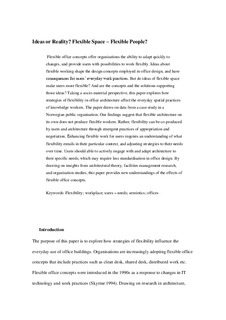| dc.contributor.author | Søiland, Elisabeth | |
| dc.contributor.author | Hansen, Geir Karsten | |
| dc.date.accessioned | 2020-03-13T09:37:46Z | |
| dc.date.available | 2020-03-13T09:37:46Z | |
| dc.date.created | 2019-02-26T18:11:41Z | |
| dc.date.issued | 2019 | |
| dc.identifier.citation | Intelligent Buildings International. 2019, . | nb_NO |
| dc.identifier.issn | 1750-8975 | |
| dc.identifier.uri | http://hdl.handle.net/11250/2646676 | |
| dc.description.abstract | Flexible office concepts offer organisations the ability to adapt quickly to changes, and provide users with possibilities to work flexibly. Ideas about flexible working shape the design concepts employed in office design, and have consequences for users’ everyday work practices. But do ideas of flexible space make users more flexible? And are the concepts and the solutions supporting those ideas? Taking a socio-material perspective, this paper explores how strategies of flexibility in office architecture affect the everyday spatial practices of knowledge workers. The paper draws on data from a case study in a Norwegian public organisation. Our findings suggest that flexible architecture on its own does not produce flexible workers. Rather, flexibility can be co-produced by users and architecture through emergent practices of appropriation and negotiation. Enhancing flexible work for users requires an understanding of what flexibility entails in their particular context, and adjusting strategies to their needs over time. Users should able to actively engage with and adapt architecture to their specific needs, which may require less standardisation in office design. By drawing on insights from architectural theory, facilities management research, and organisation studies, this paper provides new understandings of the effects of flexible office concepts. | nb_NO |
| dc.language.iso | eng | nb_NO |
| dc.publisher | Taylor & Francis | nb_NO |
| dc.title | Ideas or Reality? Flexible Space - Flexible People? | nb_NO |
| dc.type | Journal article | nb_NO |
| dc.type | Peer reviewed | nb_NO |
| dc.description.version | acceptedVersion | nb_NO |
| dc.source.pagenumber | 14 | nb_NO |
| dc.source.journal | Intelligent Buildings International | nb_NO |
| dc.identifier.doi | 10.1080/17508975.2019.1573355 | |
| dc.identifier.cristin | 1680904 | |
| dc.description.localcode | This is an [Accepted Manuscript] of an article published by Taylor & Francis, available at https://doi.org/10.1080/17508975.2019.1573355 | nb_NO |
| cristin.unitcode | 194,61,50,0 | |
| cristin.unitname | Institutt for arkitektur og planlegging | |
| cristin.ispublished | true | |
| cristin.fulltext | original | |
| cristin.qualitycode | 1 | |
